UV protection from within: Discover natural nutrients that strengthen your skin cells.
The sun’s rays make us happy – but they also cause our skin to age much faster. UV-related skin damage is responsible for up to 80 % of visible skin ageing. In addition to sun protection from the outside, new studies show that protection from the inside is also crucial.
This is because modern environmental factors such as a thinning ozone layer, air pollution and a nutrient-poor diet are weakening our natural protective mechanisms.
So it’s time to combine sun enjoyment and cell protection – with the power of intelligent, natural active ingredients.
In this article you will find out:
- What UV rays really do to your skin
- Why conventional sun protection alone is not enough
- Which nutrients have been scientifically proven to protect from the inside
- And how you can protect your skin from photoaging in the long term
How UV radiation damages your skin cells
UV rays are invisible but powerful. They penetrate various layers of the skin and cause oxidative damage. In concrete terms, this means
- DNA damage: increased risk of mutations and cell changes
- Collagen degradation: loss of elasticity, wrinkling
- Mitochondrial stress: loss of energy, slower regeneration
- Inflammation: due to free radicals and impaired cell function
While UVB rays cause sunburn and superficial damage, UVA rays penetrate deeper and cause long-term cell ageing – even without visible reddening.
And: UV rays are also effective in cloudy weather, in the shade or at the window. Anyone who relies on “I was only outside for a short time” is underestimating the risk.
The reality in a face: UV damage, made visible
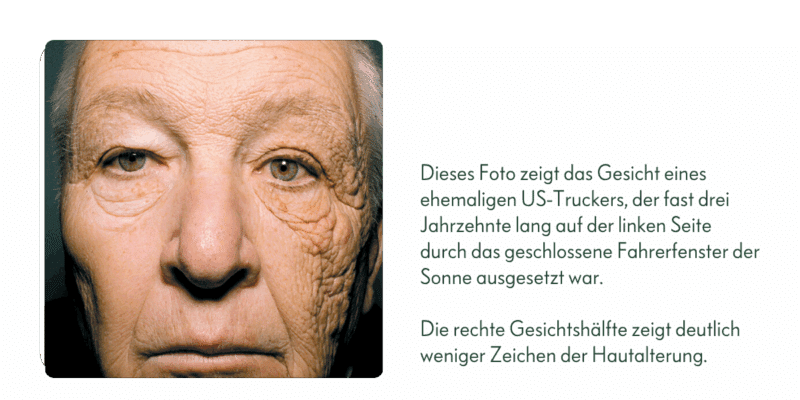
A drastic example of photoaging caused by UVA radiation, which easily penetrates glass and penetrates deep into the skin – even without sunburn.
🧡 What we learn from this:
Sun damage occurs gradually – but it can be avoided if we consistently protect our skin: from the outside AND from the inside.
The consequences of unprotected exposure to the sun
Science calls it photoaging – light-induced skin ageing. The signs often appear gradually, but they add up:
- Deeper wrinkles, especially around the eyes and mouth
- Irregular pigmentation, sun spots, age spots
- Visible veins (e.g. on the nose or cheeks)
- Rough, dry or leathery skin texture
- Lost elasticity due to degraded collagen
- Inflammatory skin reactions due to impaired skin barrier
Free radicals are the main culprits here: highly reactive molecules that attack cell structures. The more of these are produced by UV rays, the faster your skin ages – and the more difficult it is to regenerate.
UV protection from within means strengthening the skin cells with targeted nutrients so that they can actively ward off UV-induced damage.
Cell protection from within: The three strongest active ingredients against UV damage
UV protection from the inside has long been more than just a trend – it is a scientifically proven strategy for slow aging.
The best strategy against light-induced skin ageing? Systemic protection that strengthens the skin cells before damage occurs – holistic, natural and scientifically proven. Three active ingredients play a central role in this:
1. holimel® – the clinically tested UV protection from a special melon
Holimel® is a patented extract from a particularly antioxidant-rich cantaloupe melon variety. The active ingredient provides a highly active form of superoxide dismutase (SOD) – one of the body’s most important enzymes against oxidative cell damage – in microencapsulated form.
Clinically proven effects:
- +27 % higher UV resistance of the skin after 1 month
- -72 % fewer sunburned cells (sunburn cells)
- +63 % activity of antioxidant enzymes such as SOD, GPx and CAT
The effect has been proven both orally and topically. Holimel® helps the skin to neutralize free radicals caused by the sun and the environment more quickly and thus has a targeted effect against collagen degradation and DNA damage.
🧡 Contained in:
👉 Beauty Fuel – our plant-based 4-in-1 complex for moisture, elasticity, glow and natural UV protection from within.
-
Bestseller
Beauty Fuel
Plant-based 4-in-1 formula with GreenIuronic® hyaluronic acid for plump moisture, firm contours and glow69,90 €2.306,93 € / kg
-
Set 2x Beauty Fuel | Skin Radiance Complex
2-pack Bio Skin Radiance Complex - with Greenluronic® for more moisture, glow and slow aging from within132,80 €139,80 €2.306,93 €2.191,42 € / kg
2 OPC – the powerful radical scavenger from pine bark and co
OPC (oligomeric proanthocyanidins) is a secondary plant substance with an impressive antioxidant effect. It has been proven to protect skin cells from oxidative stress – and works synergistically with vitamin C.
Studies show:
- 40-100 mg OPC daily reduce visible light damage
- Up to 40 times more effective than vitamin E
- Prolongs the effect of vitamin C by a factor of 10
OPC not only protects against cell mutations, but also inhibits the enzyme elastase, which breaks down our elastin – the elasticity of our skin.
🧡 Contained in:
👉 Beauty Fuel – together with Holimel® for double cell protection against UV stress and skin ageing
👉 Cellular Life – for holistic antioxidant support against environmental pollution and oxidative stress
-
Bestseller
Beauty Fuel
Plant-based 4-in-1 formula with GreenIuronic® hyaluronic acid for plump moisture, firm contours and glow69,90 €2.306,93 € / kg
-
Bestseller
Cellular Life
Certified organic cell protection complex with nature's most powerful antioxidants69,90 €1.815,58 € / kg
3. astaxanthin – nature’s most powerful carotenoid
Astaxanthin is a deep red colored active ingredient from microalgae – and is considered the strongest natural antioxidant. It works where other substances cannot reach: in the cell membranes.
Occupied effects:
- Improves skin elasticity and moisture
- Reduces UV-induced skin redness
- Protects eyes and nerve cells
- Strengthens the immune system – ideal for intensive sun exposure
Astaxanthin is lipophilic, i.e. fat-soluble, and perfectly complements water-soluble protective substances such as OPC or vitamin C. Ideal for outdoor enthusiasts, athletes and frequent travelers.
🧡 Contained in: Asta Deluxe – our premium organic astaxanthin from the algae Haematococcus pluvialis for sun, performance and simply beautiful skin.
-
Asta Deluxe
Premium organic astaxanthin 8 mg from the algae Haematococcus pluvialis39,90 €1.108,33 € / kg
Moisture & protective barrier: Why hyaluronic acid and ceramides are indispensable in summer
In addition to antioxidant cell protection from the inside, your skin also needs one thing in particular in summer: moisture and a strong barrier function. This is because UV radiation, heat, wind and salt or chlorinated water stress the skin – it loses water more quickly, becomes drier, more sensitive and more susceptible to irritation.
Hyaluronic acid – plump moisture for plump skin
Hyaluronic acid is the body’s own moisture magnet – it can bind 1000 times its own weight in water. With increasing age (and sun), its natural production decreases – wrinkles, tightness and dryness are the result.
Studies show:
- Oral intake visibly improves skin hydration in 6-12 weeks
- Dryness lines are reduced
- The skin becomes smoother, more elastic and better moisturized
- The effect is enhanced in combination with ceramides
🧡 Contained in:
👉 Beauty Fuel – for daily moisturizing from the depths, combined with antioxidants and cell protection
👉 You can read more about hyaluronic acid and its effects in our article“Hyaluronic acid capsules: what they can really do”
Ceramides – the invisible protective barrier for your skin
Ceramides are natural lipids and an essential component of the skin barrier. They lock in moisture and keep harmful substances out. However, with age – and sun exposure – their content decreases. As a result, the skin becomes more permeable, drier and more sensitive.
What ceramides do:
- Strengthen the skin barrier
- Reduce moisture loss
- Smoothes dryness lines
- Soothe irritated, stressed skin
🧡 Contained in:
👉 Timeless Skin – our moisturizing skin barrier complex with phytoceramides from gluten-free wheat extract and squalene
👉 You can find out more about the power of ceramides in our article“Dry skin and wrinkles: It could be ceramide deficiency”
-
Bestseller
Beauty Fuel
Plant-based 4-in-1 formula with GreenIuronic® hyaluronic acid for plump moisture, firm contours and glow69,90 €2.306,93 € / kg
SPF remains mandatory – but is only half the battle
External sun protection is essential – even if you use supplements. Why?
- UV damage is cumulative – every day counts
- Clouds do not protect – UVA penetrates even glass
- Sunscreen alone does not protect against cell damage – it only blocks part of the rays
☀️ What you should do:
- Use mineral sunscreen with SPF 30+ every day
- Never mix sun cream with make-up – otherwise it loses its effect
- Reapply cream every two hours, especially after swimming or sweating
The combination of SPF + inner cell protection + moisturizer offers you the most effective protection against UV-induced skin aging – smart, holistic and skin-friendly.
Conclusion: Skin ageing begins in the cell – so does protection
UV rays are active all year round. Whether on summer vacation, on a walk in spring, through the office window or on the ski slopes – the sun is always there, even if we can’t see or feel it. And with it the processes that slowly but steadily age our skin.
Much of this damage happens invisibly and insidiously – at a molecular level. Oxidative stress, free radicals, inflammatory micro-reactions. What we see is the end result: wrinkles, pigmentation spots, loss of elasticity. But the origin lies deeper – in our cells.
The good news? You can start here.
With active ingredients such as Holimel®, which increase your skin’s natural resistance to UV-induced damage. With OPC, which neutralizes free radicals before they cause damage. With astaxanthin, which protects your cell membranes, especially when exposed to screen light, sport or environmental stress. And with hyaluronic acid and ceramides, which stabilize your skin barrier from the inside.
The difference is not whether your skin is exposed to UV rays – but how well it is prepared for them.
We believe that sustainable skincare is not seasonal. It starts every day – from the inside. And it accompanies you all year round: silently, reliably and noticeably.
This keeps your skin not only beautiful – but strong.
Discover Ogaenics cell protection – for skin that can do more
-
Asta Deluxe
Premium organic astaxanthin 8 mg from the algae Haematococcus pluvialis39,90 €1.108,33 € / kg
-
Bestseller
Beauty Fuel
Plant-based 4-in-1 formula with GreenIuronic® hyaluronic acid for plump moisture, firm contours and glow69,90 €2.306,93 € / kg
-
Bestseller
Cellular Life
Certified organic cell protection complex with nature's most powerful antioxidants69,90 €1.815,58 € / kg

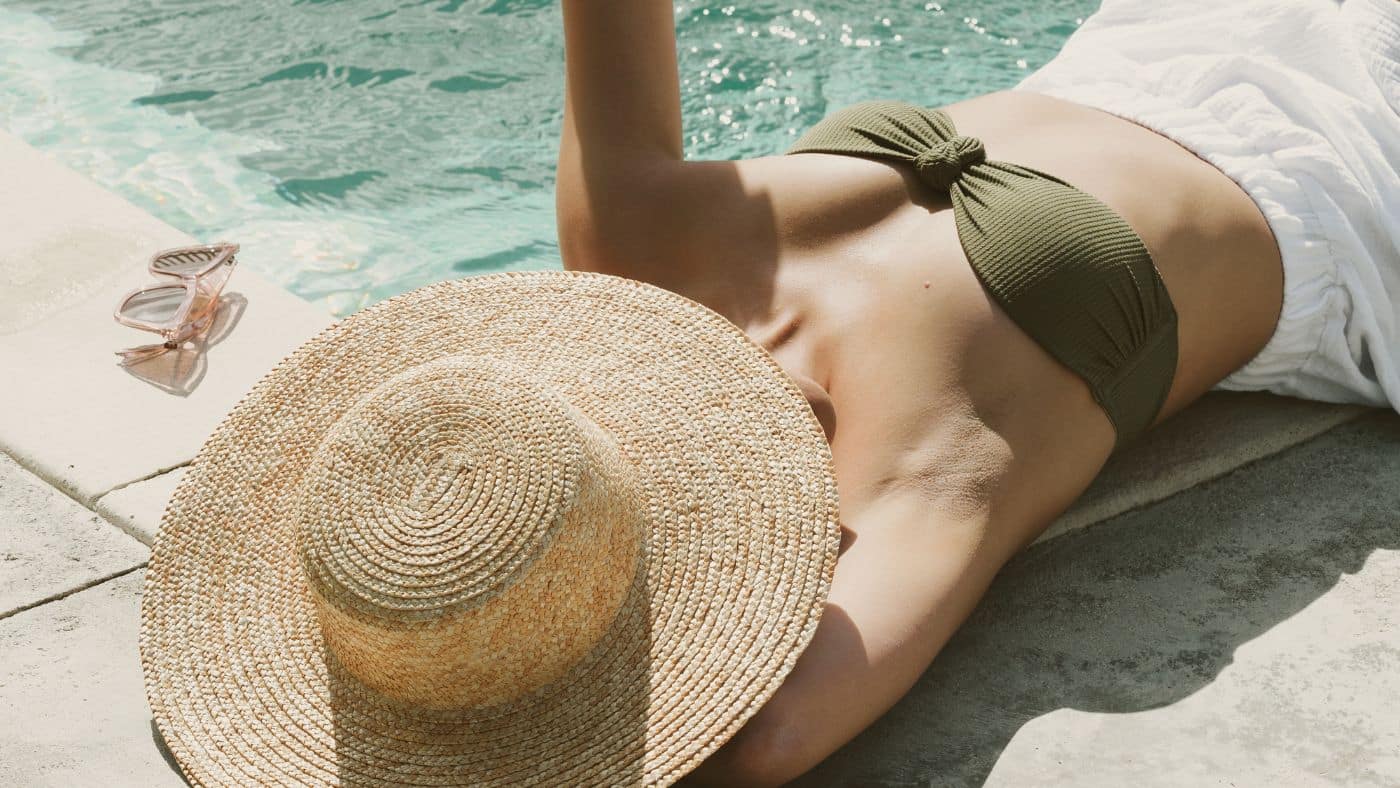
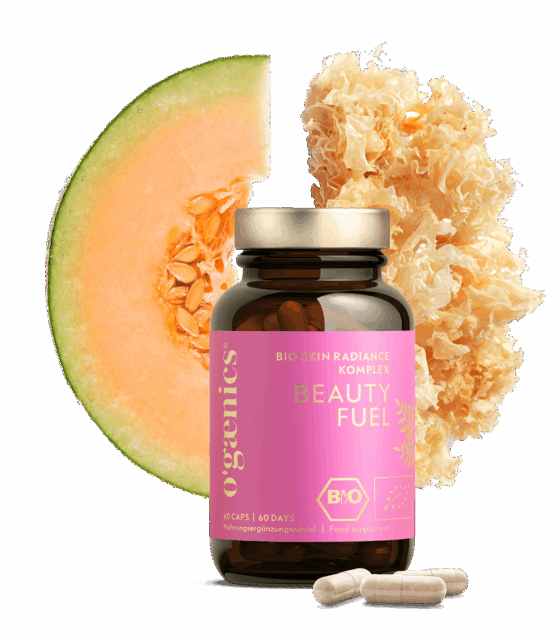

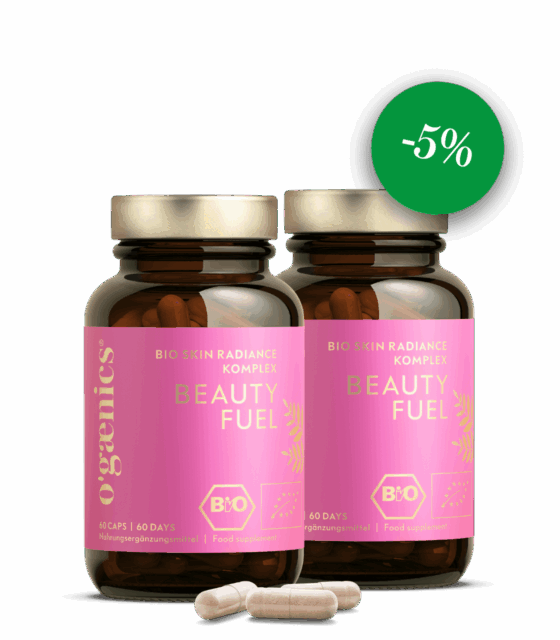
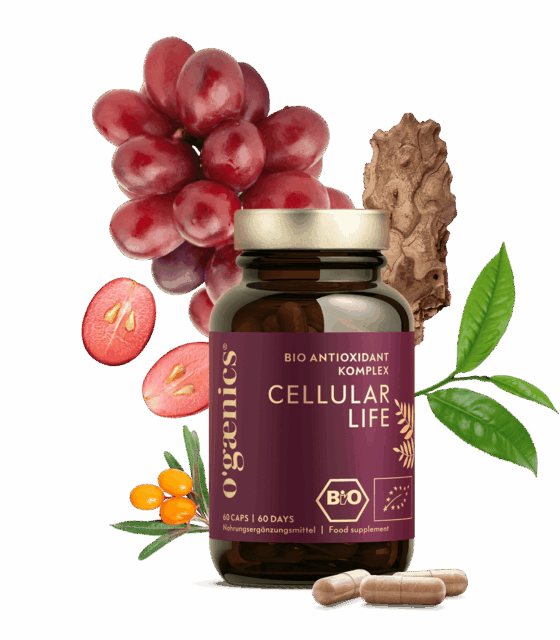

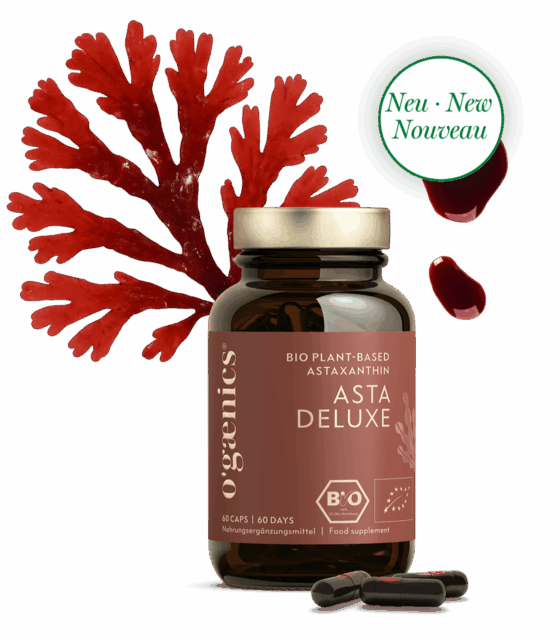
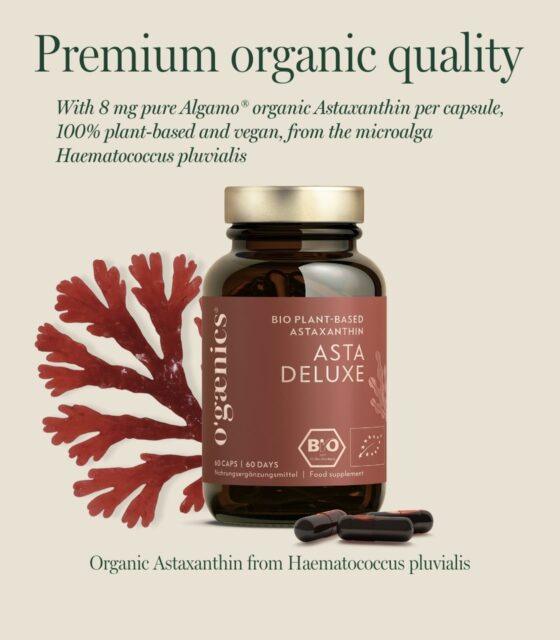
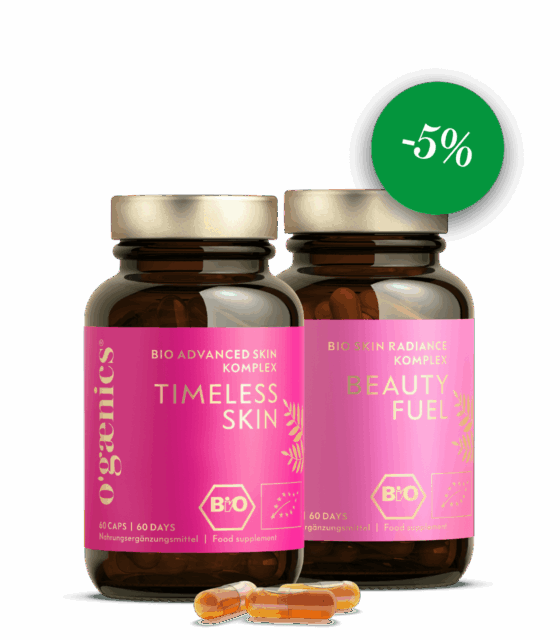
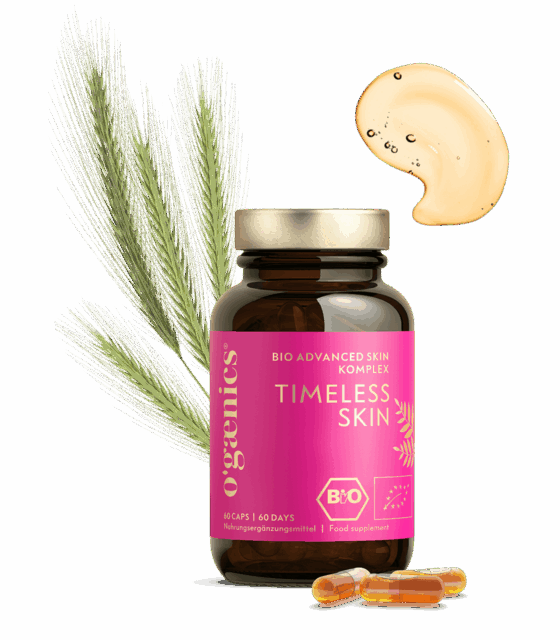
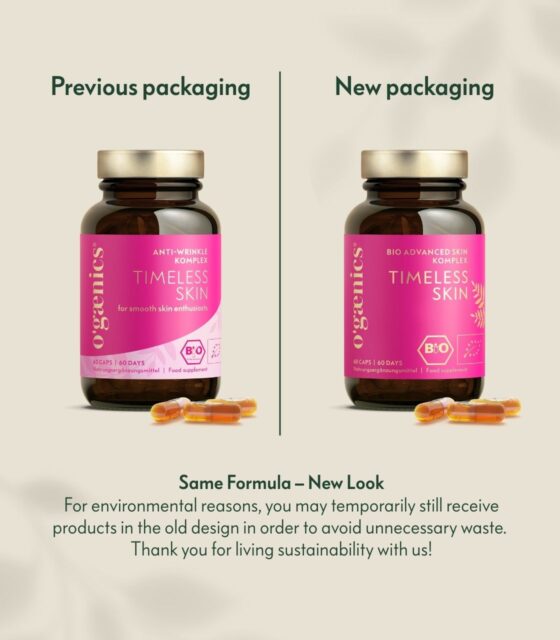
 No products in the cart.
No products in the cart.